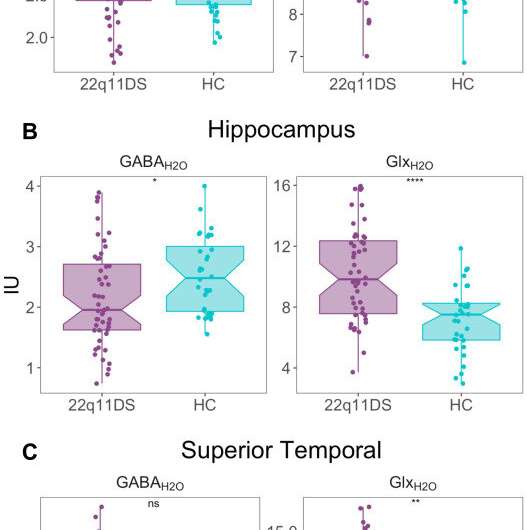This article has been reviewed according to Science X's editorial process and policies. Editors have highlighted the following attributes while ensuring the content's credibility:
fact-checked
peer-reviewed publication
trusted source
proofread
Excitatory-inhibitory neurotransmitter imbalance precedes psychosis

Dysregulation of the dopamine neurotransmitter system has long been associated with schizophrenia and other forms of psychosis, but recently researchers have begun to examine the glutamate and GABA systems as well.
Studies have shown that an excitatory-inhibitory imbalance begins with improperly functioning NMDA-type glutamate receptors (NMDAR) in temporal regions of the brain, but much of the evidence comes from studies of the brains of psychotic people, leaving in question whether the imbalance results from psychotic symptoms or precedes them.
Now, a new study in people with the copy variant number 22q11.2 deletion syndrome (22q11DS) probes the excitatory-inhibitory neurotransmitter system prior to the onset of psychosis. Deletion carriers have a strong predisposition for psychiatric illnesses including anxiety and mood disorders, and they have a 30% lifetime risk of developing psychotic disorders, including schizophrenia, by adulthood.
These carriers present a unique opportunity for longitudinal studies on neuropsychiatric illnesses because of the possibility of study and follow-up before and after the onset of such illnesses.
The study appears in Biological Psychiatry.
Researchers led by Valentina Mancini, Ph.D., at the University of Geneva School of Medicine, used magnetic resonance imaging (MRI) together with proton magnetic resonance spectroscopy (MRS) to estimate levels of the excitatory neurotransmitters glutamate and glutamine (Glx), and the inhibitory neurotransmitter GABA in the brains of 60 individuals with 22q11DS and 45 healthy controls.
They focused on three brain regions implicated in schizophrenia pathophysiology: the anterior cingulate cortex (ACC), superior temporal cortex (STC), and hippocampus.
Deletion carriers had higher levels of Glx in hippocampus and STC, but not in the ACC, compared to controls. Carriers also had significantly lower levels of GABA in the hippocampus, but not the ACC or STC. Importantly, among 22q11DS carriers, those with psychosis also had higher Glx levels in the hippocampus, suggesting that changes in the hippocampus may drive downstream pathology.
Atrophy of the hippocampus has also been observed in the brains of people with schizophrenia. In the current study, Glx concentration was associated with greater atrophy, perhaps pointing to an elevated vulnerability of the hippocampus.
"Our results highlight that temporo-limbic regions, and in particular the hippocampus, undergo a progressive shift in the ratio between the concentration of excitatory and inhibitory neurotransmitters," said Dr. Mancini.
"Moreover, we found that those individuals with higher levels of excitatory neurotransmitter also had a higher extent of hippocampal volume loss over time. These individuals also started to experience psychotic symptoms, such as hallucinations and delusions. Our study provides novel insight into potential mechanisms underlying hippocampal atrophy in individuals at risk for psychosis and links these neural abnormalities to the emergence of psychotic symptoms."
John Krystal, MD, Editor of Biological Psychiatry, said of the work, "This study of 22q.11 deletion syndrome, a syndrome with increased risk for schizophrenia, elegantly builds on prior findings linking excessive glutamate release to smaller cortical volumes, suggestive of atrophy. This form of atrophy may contribute to cognitive and functional impairments."
The work may have clinical implications, Dr. Mancini added. "The current findings can inform novel treatment strategies targeting early glutamatergic dysfunction in individuals at risk for psychosis. Given the essential role of the hippocampus in memory processes, preventing excitatory-inhibitory imbalance and volume loss could potentially mitigate the cognitive decline typically observed in psychotic patients."
More information: Valentina Mancini et al, Excitatory inhibitory imbalance underlies hippocampal atrophy in individuals with 22q11.2 Deletion Syndrome with psychotic symptoms, Biological Psychiatry (2023). DOI: 10.1016/j.biopsych.2023.03.021


















